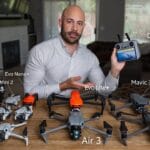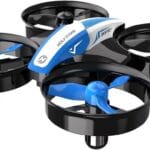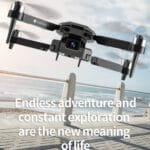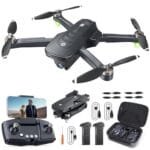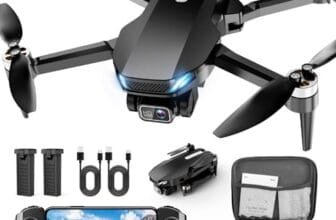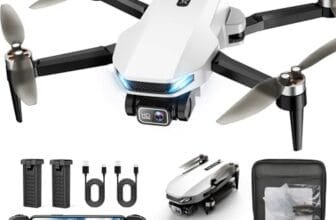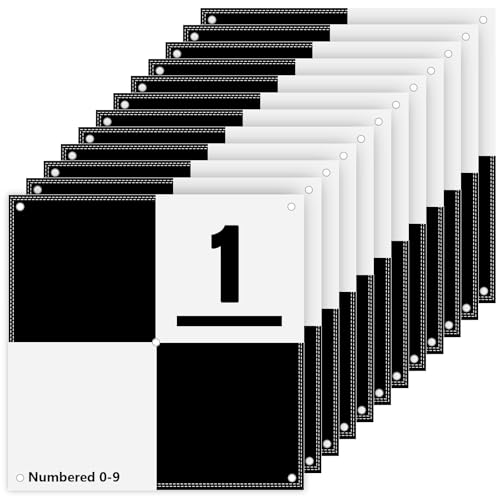
Drones have transformed the surveying industry, offering precision and efficiency. Choosing the right drone is crucial for successful projects.
Surveying with drones provides a bird’s-eye view, enabling detailed data collection. The right tools can enhance this process significantly. For instance, the Cyiwniao 10 Pack Drone Ground Control Points aid in accurate mapping, with numbered markers for easy identification. The E1 Lite RTK Base Station offers high accuracy for GNSS GPS, crucial for precise surveys.
Understanding drone photogrammetry fundamentals can also improve mapping results. Accessories like the CYNOVA Landing Pad protect your drone during takeoff and landing. Additionally, resources like OpenDroneMap guide users in using free software for mapping. Selecting the best drone components ensures efficient and accurate surveying results.
Cyiwniao 10 Pack Drone Ground Control Point Gcp

The Cyiwniao 10 Pack Drone Ground Control Point GCP is an essential tool for professionals in mapping and surveying. Ideal customers include surveyors, cartographers, and UAV pilots who require precise aerial targets for their projects. These markers are crucial for achieving accurate geospatial data and optimizing drone operations.
Pros:
- High visibility with black/white markers for clear identification from the air.
- Durable material ensures longevity and consistent performance.
- Numbered eyelets make organization and tracking easy during complex surveying tasks.
Cons:
- Size might be challenging to manage in densely vegetated areas.
- Weight could be a factor when transporting multiple units over long distances.
The features of the Cyiwniao 10 Pack Drone Ground Control Point GCP are designed to enhance the efficiency and accuracy of mapping and surveying tasks. The black/white color scheme provides excellent contrast against various terrains, making it easier for drones to capture precise data. This is particularly beneficial for professionals working in diverse environments who need reliable markers that stand out.
Additionally, the center eyelet and numbering system offer streamlined organization, allowing users to quickly set up and reference points during their projects. This is advantageous for surveyors who often work under time constraints and require efficient methods to mark their control points. Overall, these features contribute to improved workflow and heightened data accuracy, making the Cyiwniao GCPs a valuable asset for anyone involved in aerial mapping.
To buy this product, click here.
E1 Lite Rtk Base Station

The E1 Lite RTK Base Station is ideal for surveyors, drone operators, and RTK rover users who require high accuracy in their GNSS GPS data collection. This device is especially suitable for professionals seeking precision and reliability in challenging environments, making it a valuable asset for mapping and land surveying tasks.
Pros:
- High accuracy GNSS GPS receiver
- FCC certified for compliance
- Compatible with third-party GNSS RTK receivers
- Portable dimensions for easy transport
Cons:
- Tripod excluded, requiring additional purchase
- Limited color options (White/grey only)
The E1 Lite RTK Base Station offers exceptional features such as high accuracy GNSS GPS reception, which is crucial for surveying and mapping applications. This precision ensures that data collected is reliable and can be used confidently in professional settings. The compatibility with third-party GNSS RTK receivers expands its utility, allowing users to integrate it seamlessly into existing equipment setups without hassle.
Its compact dimensions make the E1 Lite RTK Base Station highly portable, allowing professionals to easily transport it between job sites. Despite its size, it maintains robust performance, ensuring that users do not have to compromise on quality for convenience. The device’s FCC certification provides an added layer of assurance for compliance with regulations, making it a trustworthy choice for those in need of a dependable surveying solution.
To buy this product, click here.
The Fundamentals Of Drone Photogrammetry, Mapping, And Survey

The ideal customer for “The Fundamentals of Drone Photogrammetry, Mapping, and Survey” is a professional surveyor, geospatial analyst, or drone enthusiast looking to expand their knowledge in the field of drone-based mapping and surveying techniques. This book is perfect for those who wish to harness the power of drones for accurate mapping, land surveying, and geospatial data collection.
Pros:
- Comprehensive guide on drone photogrammetry
- Detailed explanations of mapping techniques
- Up-to-date content relevant for future technologies
Cons:
- Technical language may be challenging for beginners
- Limited coverage on non-photogrammetry topics
One of the standout features of this book is its comprehensive coverage of drone photogrammetry. The book delves into the technical aspects of using drones for mapping and surveying, providing step-by-step guidance on how to achieve high-precision results. This makes it an invaluable resource for professionals who are keen on refining their skills and understanding the intricacies of geospatial data collection using drones.
Additionally, the book provides detailed explanations of various mapping techniques, supported by real-world examples. This practical approach helps readers to not only grasp the theoretical concepts but also see how they are applied in real-world scenarios. The inclusion of up-to-date content ensures that readers are learning techniques that are relevant and applicable to current and emerging technologies in the field of drone surveying.
To buy this product, click here.
Cynova Drone Landing Pad

The CYNOVA 3.33 FT Drone Landing Pad is designed for professional photographers, surveyors, and those involved in agriculture who require a reliable and durable landing surface for their drones. If you’re someone who frequently uses drones in various environments and needs a sturdy, waterproof, and wind-resistant pad, this product is perfect for you.
Pros:
- Weighted design ensures stability in windy conditions.
- Waterproof PU leather material protects against moisture.
- Foldable for easy transport and storage.
- Large 40-inch diameter accommodates most drones.
Cons:
- Orange color may not blend in with natural surroundings.
- 0.2-inch thickness may not provide cushioning on rocky surfaces.
The CYNOVA Drone Landing Pad features a weighted design that provides exceptional stability, making it ideal for use in windy conditions where other landing pads might falter. This is especially beneficial for those operating in open fields or elevated terrains where wind is a common challenge. The waterproof PU leather material offers robust protection against unexpected rain showers or morning dew, ensuring your landing pad remains dry and in optimal condition for every drone mission.
Additionally, the large 40-inch diameter of the pad provides ample space for a wide range of drone sizes, from compact consumer models to larger professional drones used in photography, surveying, and agriculture. The foldable design makes it incredibly easy to carry and store, allowing users to quickly set up and pack away the pad without hassle. While the orange color ensures visibility, it might stand out in natural settings, but this can also be a benefit for locating the pad from a distance.
To buy this product, click here.
Opendronemap: The Missing Guide

The ideal customer for “OpenDroneMap: The Missing Guide: A Practical Guide To Drone Mapping Using Free and Open Source Software, Second Edition” is anyone interested in drone mapping and looking to utilize free and open source software. This book is perfect for hobbyists, researchers, and professionals who want to understand the practical aspects of drone mapping without investing in expensive proprietary tools.
Pros:
- Provides an in-depth understanding of open-source drone mapping
- Suitable for beginners and advanced users alike
- Cost-effective solution with free software guidance
- Comprehensive guide with 308 pages of detailed information
Cons:
- Limited to English language publication
- Requires technical familiarity with drone operations
This book, published on 2023-06-18, offers a well-structured approach to understanding the nuances of drone mapping using open source tools. It covers everything from basic setup to advanced techniques, making it a valuable resource for those serious about drone mapping. The independently published guide ensures that readers receive unbiased information tailored to maximize the potential of free software.
The detailed features of the book include its compact dimensions (Height: 9.0 inches, Width: 0.73 inches, Length: 6.0 inches, Weight: 1.17 Pounds), making it easy to carry and reference while working in the field. With 308 pages, it dives deep into practical applications, offering step-by-step instructions that empower users to transform their drone mapping projects efficiently and effectively.
To buy this product, click here.
Frequently Asked Questions
What Are Ground Control Points In Drone Surveying?
Ground Control Points (GCPs) are essential for accurate drone mapping. They are marked locations on the ground with known coordinates. These points help improve the precision of aerial surveys. Using GCPs ensures that the drone’s images align correctly with real-world coordinates.
This enhances the overall accuracy of the survey results.
How Does An Rtk Base Station Work For Drones?
An RTK Base Station provides high-accuracy GPS corrections to drones. It communicates with the drone’s GNSS receiver to improve positioning accuracy. This process reduces errors in location data. RTK technology is crucial for precise surveying tasks, ensuring that data is reliable and accurate.
It is widely used in professional mapping projects.
Why Use A Drone Landing Pad For Surveying?
A drone landing pad offers a stable surface for takeoff and landing. It protects the drone from debris and uneven ground. Landing pads also enhance visibility, making it easier to spot the landing area. They are especially useful in challenging terrains or agricultural fields.
This ensures safe and precise drone operations.
What Is Drone Photogrammetry And Mapping?
Drone photogrammetry uses aerial images to create maps and 3D models. Drones capture high-resolution images from above. These images are processed to generate accurate geographic representations. Photogrammetry is widely used in surveying, construction, and agriculture. It provides detailed insights into land features and structures.
How Does Opendronemap Aid In Drone Mapping?
OpenDroneMap is a free, open-source software for processing drone imagery. It converts aerial photos into maps and 3D models. The software is user-friendly and supports various file formats. It is ideal for those seeking cost-effective mapping solutions. OpenDroneMap facilitates efficient and accurate drone survey projects.
Conclusion
Selecting the right drone for surveying can significantly enhance your projects. Each tool offers unique features tailored for different tasks. Cyiwniao markers provide clear ground control points essential for accurate mapping. The e1 lite rtk base station ensures high-precision gps data collection.
Understanding drone photogrammetry and mapping fundamentals can improve the quality of your surveys. The cynova landing pad offers stability for safe takeoffs and landings, especially in challenging environments. Opendronemap provides valuable insights into using open-source software for efficient mapping projects.
Each of these resources contributes to creating accurate and reliable survey data. Choosing wisely can simplify your workflow and ensure successful outcomes. Consider your specific needs and project requirements when selecting from these options. With the right tools, surveying with drones can be effective and rewarding.
Remember, well-planned surveys lead to better results.
